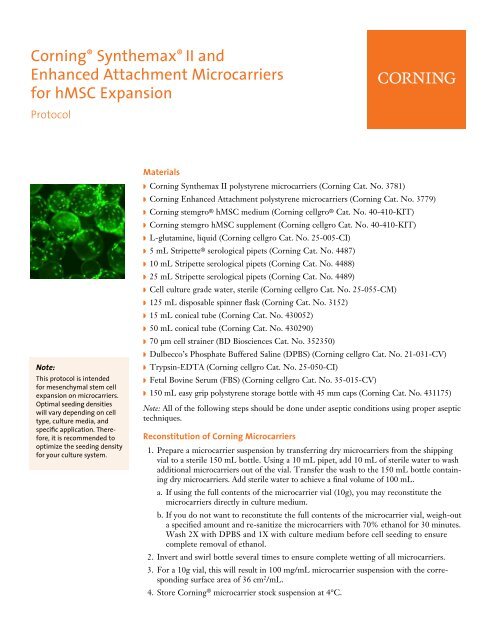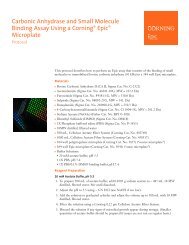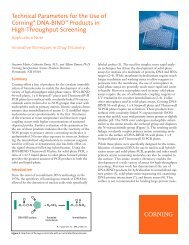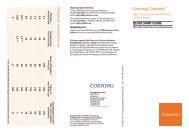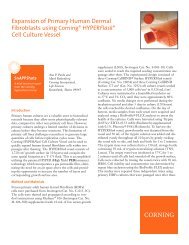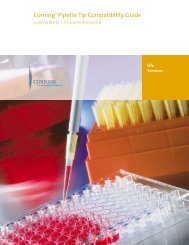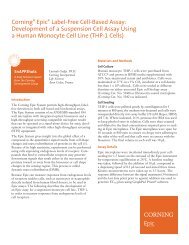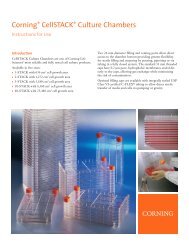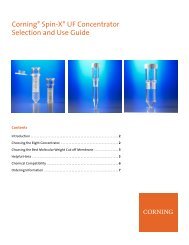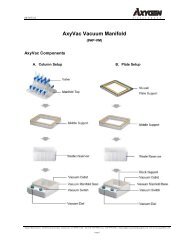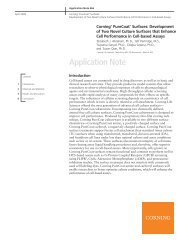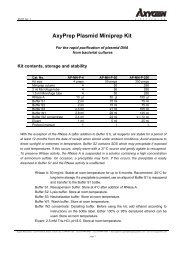Corning® Synthemax® II and Enhanced Attachment Microcarriers ...
Corning® Synthemax® II and Enhanced Attachment Microcarriers ...
Corning® Synthemax® II and Enhanced Attachment Microcarriers ...
Create successful ePaper yourself
Turn your PDF publications into a flip-book with our unique Google optimized e-Paper software.
Corning ® Synthemax ® <strong>II</strong> <strong>and</strong><br />
<strong>Enhanced</strong> <strong>Attachment</strong> <strong>Microcarriers</strong><br />
for hMSC Expansion<br />
Protocol<br />
Note:<br />
This protocol is intended<br />
for mesenchymal stem cell<br />
expansion on microcarriers.<br />
Optimal seeding densities<br />
will vary depending on cell<br />
type, culture media, <strong>and</strong><br />
specific application. Therefore,<br />
it is recommended to<br />
optimize the seeding density<br />
for your culture system.<br />
Materials<br />
w Corning Synthemax <strong>II</strong> polystyrene microcarriers (Corning Cat. No. 3781)<br />
w Corning <strong>Enhanced</strong> <strong>Attachment</strong> polystyrene microcarriers (Corning Cat. No. 3779)<br />
w Corning stemgro ® hMSC medium (Corning cellgro ® Cat. No. 40-410-KIT)<br />
w Corning stemgro hMSC supplement (Corning cellgro Cat. No. 40-410-KIT)<br />
w L-glutamine, liquid (Corning cellgro Cat. No. 25-005-CI)<br />
w 5 mL Stripette ® serological pipets (Corning Cat. No. 4487)<br />
w 10 mL Stripette serological pipets (Corning Cat. No. 4488)<br />
w 25 mL Stripette serological pipets (Corning Cat. No. 4489)<br />
w Cell culture grade water, sterile (Corning cellgro Cat. No. 25-055-CM)<br />
w 125 mL disposable spinner flask (Corning Cat. No. 3152)<br />
w 15 mL conical tube (Corning Cat. No. 430052)<br />
w 50 mL conical tube (Corning Cat. No. 430290)<br />
w 70 µm cell strainer (BD Biosciences Cat. No. 352350)<br />
w Dulbecco’s Phosphate Buffered Saline (DPBS) (Corning cellgro Cat. No. 21-031-CV)<br />
w Trypsin-EDTA (Corning cellgro Cat. No. 25-050-CI)<br />
w Fetal Bovine Serum (FBS) (Corning cellgro Cat. No. 35-015-CV)<br />
w 150 mL easy grip polystyrene storage bottle with 45 mm caps (Corning Cat. No. 431175)<br />
Note: All of the following steps should be done under aseptic conditions using proper aseptic<br />
techniques.<br />
Reconstitution of Corning <strong>Microcarriers</strong><br />
1. Prepare a microcarrier suspension by transferring dry microcarriers from the shipping<br />
vial to a sterile 150 mL bottle. Using a 10 mL pipet, add 10 mL of sterile water to wash<br />
additional microcarriers out of the vial. Transfer the wash to the 150 mL bottle containing<br />
dry microcarriers. Add sterile water to achieve a final volume of 100 mL.<br />
a. If using the full contents of the microcarrier vial (10g), you may reconstitute the<br />
microcarriers directly in culture medium.<br />
b. If you do not want to reconstitute the full contents of the microcarrier vial, weigh-out<br />
a specified amount <strong>and</strong> re-sanitize the microcarriers with 70% ethanol for 30 minutes.<br />
Wash 2X with DPBS <strong>and</strong> 1X with culture medium before cell seeding to ensure<br />
complete removal of ethanol.<br />
2. Invert <strong>and</strong> swirl bottle several times to ensure complete wetting of all microcarriers.<br />
3. For a 10g vial, this will result in 100 mg/mL microcarrier suspension with the corresponding<br />
surface area of 36 cm 2 /mL.<br />
4. Store Corning ® microcarrier stock suspension at 4°C.
Cell Seeding on Corning <strong>Microcarriers</strong><br />
This protocol is intended for mesenchymal stem cell expansion on microcarriers. Optimal<br />
seeding densities will vary depending on cell type, culture media, <strong>and</strong> specific application.<br />
Therefore, it is recommended to optimize the seeding density for your culture system.<br />
1. Add 4 mL of Corning microcarrier stock suspension (400 mg) to a 15 mL conical tube,<br />
<strong>and</strong> allow microcarriers to settle (~2 minutes).<br />
2. Using a 5 mL pipet, gently remove the liquid without disrupting the microcarrier pellet.<br />
3. Reconstitute the microcarriers in 10 mL of culture medium, <strong>and</strong> store the microcarrier<br />
suspension at 37°C until cell seeding.<br />
4. Harvest cells according to your st<strong>and</strong>ard protocols, <strong>and</strong> prepare a suspension of 500,000<br />
to 750,000 cells in 5 mL of culture medium (Note: A cell number of 500,000-750,000 can<br />
be used as a starting point; however, we recommend optimizing the seeding density for<br />
each culture system).<br />
5. Combine the 10 mL microcarrier suspension from step 3 <strong>and</strong> the 5 mL cell suspension<br />
from step 4 in a disposable 125 mL disposable spinner flask. This will result in a seeding<br />
density of ~3500 to 5000 cells/cm 2 microcarriers.<br />
6. Place spinner flask containing the microcarrier <strong>and</strong> cell suspension in 37°C/5% CO 2<br />
humidified incubator <strong>and</strong> gently rock flask to evenly distribute cells <strong>and</strong> microcarriers.<br />
7. Incubate for 18 to 24 hours under static conditions to allow for cell adhesion (Note:<br />
The duration of the static phase can vary depending on the cell type <strong>and</strong> culture media.<br />
Therefore, we recommend optimizing it for each culture system).<br />
8. After 18 to 24 hours, bring culture to a final volume of 45 mL with fresh culture medium<br />
<strong>and</strong> start intermittent agitation (e.g., 30 rpm for 15 minutes every 2 hours).<br />
9. Continue intermittent agitation for 4 to 7 days or until cells reach 70 to 80% confluence<br />
(Note: In our experience, 70 to 80% confluence corresponds to 30,000 to 50,000 cells/cm 2 ).<br />
10. Replenish 50% of the culture medium every 2 to 3 days. When exchanging culture medium,<br />
allow cell-microcarrier suspension to settle 5 minutes, <strong>and</strong> using a 25 mL pipet, slowly<br />
remove 50% of culture medium, <strong>and</strong> replace with fresh medium (i.e., 22.5 mL).<br />
Cell Harvest Procedure<br />
1. Using a 25 mL pipet, mix the cell-microcarrier suspension several times to ensure an<br />
even distribution. Remove a 5 to 10 mL cell-microcarrier sample; the volume should<br />
reflect the confluence of your culture to ensure an adequate harvest for meaningful cell<br />
count.<br />
2. Transfer the sample from step 1 to a 15 mL conical tube, <strong>and</strong> allow microcarriers to<br />
settle (~5 minutes).<br />
3. Gently aspirate spent culture medium being careful not to disturb the cell-microcarrier<br />
pellet.<br />
4. Wash microcarriers 2X with 10 mL of DPBS; gently aspirate DPBS wash as in step 3.<br />
5. Add 5 mL pre-warmed trypsin-EDTA, swirl tube to evenly distribute enzyme <strong>and</strong> cellmicrocarriers,<br />
<strong>and</strong> transfer tube to a 37°C incubator for 5 minutes.<br />
6. During trypsinization, prepare a 50 mL conical tube with 1 mL fetal bovine serum (FBS),<br />
<strong>and</strong> place a 70 µm cell strainer on the top of the tube.<br />
7. After trypsinization, gently mix the culture with a 5 mL pipet to ensure complete cell<br />
detachment from microcarriers ( Note: To confirm cell detachment, transfer an aliquot<br />
of the suspension to a multiple well dish, <strong>and</strong> observe under a microscope).<br />
8. Filter the cell-microcarrier suspension through the 70 µm filter into FBS to inhibit<br />
further trypsination.<br />
2
9. Wash filter 2X with 2 to 3 mL DPBS ( Note: To confirm no cells remain on the filter,<br />
transfer the filter to 1 well of a 6 well plate, <strong>and</strong> observe under a microscope).<br />
10. Pipet cell mixture 3 to 5 times to assure single-cell suspension.<br />
11. Count cells, <strong>and</strong> calculate the total cell number (Note: If cells are used for further culture<br />
or assay, we recommend to use a defined trypsin inhibitor rather than FBS in step 6).<br />
Bead-to-Bead Expansion of Cells<br />
Note: passage-free cell expansion (i.e., no enzymatic harvest) may not be applicable to all cell<br />
types <strong>and</strong> may require optimization with enzyme for your cell line <strong>and</strong> media conditions.<br />
1. Add 4 mL of fresh Corning ® microcarrier stock suspension (400 mg) to a 15 mL conical<br />
tube. Allow microcarriers to settle (~2 minutes).<br />
2. Using a 5 mL pipet, gently remove the liquid without disrupting the microcarrier pellet,<br />
<strong>and</strong> reconstitute the microcarriers in 10 mL of pre-warmed culture medium.<br />
3. Transfer the microcarrier suspension to a new spinner flask, <strong>and</strong> store at 37°C until cell<br />
seeding.<br />
4. Based upon the cell count, transfer an appropriate volume of the cell-microcarrier suspension<br />
to the pre-warmed microcarriers prepared in step 2. Adjust the final culture volume<br />
to 15 mL (For example, if your cell count is 200,000 cells per mL <strong>and</strong> you want a seeding<br />
density of 500,000 cells per spinner flask, then transfer 2.5 mL of cell-microcarrier suspension<br />
to fresh microcarriers prepared in step 2. Add an additional 2.5 mL of medium<br />
to bring the final culture volume to 15 mL).<br />
5. Place spinner flask containing microcarriers <strong>and</strong> cells in 37°C/5%CO 2 humidified<br />
incubator, <strong>and</strong> gently rock flask to evenly distribute cells <strong>and</strong> microcarriers.<br />
6. After 18 to 24 hours, bring culture to a final volume of 45 mL <strong>and</strong> start intermittent<br />
agitation (e.g., 30 rpm for 15 minutes every 2 hours).<br />
7. Continue intermittent agitation for 4 to 7 days or until cells reach 70 to 80% confluence<br />
(Note: in our experience, 70 to 80% confluence corresponds to 30,000 to 50,000 cells/cm 2 ).<br />
8. Replenish 50% of the culture medium every 2 to 3 days. When exchanging culture<br />
medium, allow cell-microcarrier suspension to settle 5 minutes, <strong>and</strong> using a 25 mL pipet,<br />
slowly remove 50% of culture medium, <strong>and</strong> replace with fresh medium (i.e., 22.5 mL).<br />
3
For additional product or technical information, please visit www.corning.com/lifesciences<br />
or call 1.800.492.1110. Outside the United States, please call 978.442.2200 or contact your<br />
local Corning sales office listed below.<br />
Corning Incorporated<br />
Life Sciences<br />
836 North St.<br />
Building 300, Suite 3401<br />
Tewksbury, MA 01876<br />
t 800.492.1110<br />
t 978.442.2200<br />
f 978.442.2476<br />
www.corning.com/lifesciences<br />
Worldwide<br />
Support Offices<br />
Asia/pacific<br />
Australia/New Zeal<strong>and</strong><br />
t 0402-794-347<br />
China<br />
t 86 21 2215 2888<br />
f 86 21 6215 2988<br />
India<br />
t 91 124 4604000<br />
f 91 124 4604099<br />
The Corning Family of Br<strong>and</strong>s<br />
Japan<br />
t 81 3-3586 1996<br />
f 81 3-3586 1291<br />
Korea<br />
t 82 2-796-9500<br />
f 82 2-796-9300<br />
Singapore<br />
t 65 6733-6511<br />
f 65 6861-2913<br />
Taiwan<br />
t 886 2-2716-0338<br />
f 886 2-2516-7500<br />
® cellgro ®<br />
For a listing of trademarks, visit us at www.corning.com/lifesciences/trademarks.<br />
Corning Incorporated, One Riverfront Plaza, Corning, NY 14831-0001<br />
Europe<br />
France<br />
t 0800 916 882<br />
f 0800 918 636<br />
Germany<br />
t 0800 101 1153<br />
f 0800 101 2427<br />
The Netherl<strong>and</strong>s<br />
t 31 20 655 79 28<br />
f 31 20 659 76 73<br />
United Kingdom<br />
t 0800 376 8660<br />
f 0800 279 1117<br />
®<br />
®<br />
All Other European<br />
Countries<br />
t 31 (0) 20 659 60 51<br />
f 31 (0) 20 659 76 73<br />
Latin America<br />
Brasil<br />
t (55-11) 3089-7419<br />
f (55-11) 3167-0700<br />
Mexico<br />
t (52-81) 8158-8400<br />
f (52-81) 8313-8589<br />
© 2012, 2013 Corning Incorporated Printed in U.S.A. 2/13 POD CLS-AN-212 REV1


